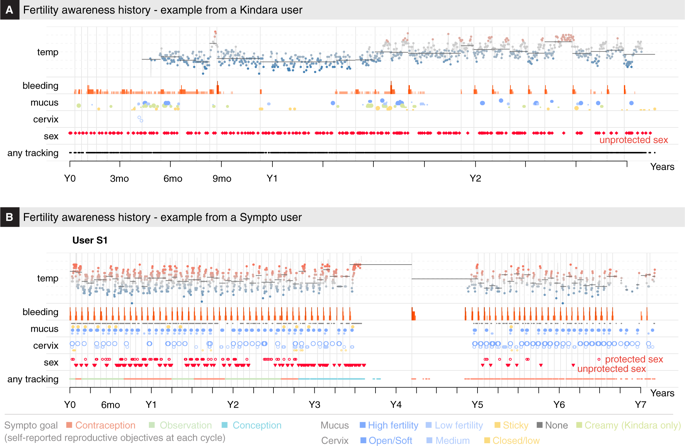npj Digital Medicine ( IF 12.4 ) Pub Date : 2019-07-16 , DOI: 10.1038/s41746-019-0139-4 Laura Symul , Katarzyna Wac , Paula Hillard , Marcel Salathé

|
For most women of reproductive age, assessing menstrual health and fertility typically involves regular visits to a gynecologist or another clinician. While these evaluations provide critical information on an individual’s reproductive health status, they typically rely on memory-based self-reports, and the results are rarely, if ever, assessed at the population level. In recent years, mobile apps for menstrual tracking have become very popular, allowing us to evaluate the reliability and tracking frequency of millions of self-observations, thereby providing an unparalleled view, both in detail and scale, on menstrual health and its evolution for large populations. In particular, the primary aim of this study was to describe the tracking behavior of the app users and their overall observation patterns in an effort to understand if they were consistent with previous small-scale medical studies. The secondary aim was to investigate whether their precision allowed the detection and estimation of ovulation timing, which is critical for reproductive and menstrual health. Retrospective self-observation data were acquired from two mobile apps dedicated to the application of the sympto-thermal fertility awareness method, resulting in a dataset of more than 30 million days of observations from over 2.7 million cycles for two hundred thousand users. The analysis of the data showed that up to 40% of the cycles in which users were seeking pregnancy had recordings every single day. With a modeling approach using Hidden Markov Models to describe the collected data and estimate ovulation timing, it was found that follicular phases average duration and range were larger than previously reported, with only 24% of ovulations occurring at cycle days 14 to 15, while the luteal phase duration and range were in line with previous reports, although short luteal phases (10 days or less) were more frequently observed (in up to 20% of cycles). The digital epidemiology approach presented here can help to lead to a better understanding of menstrual health and its connection to women’s health overall, which has historically been severely understudied.
中文翻译:

通过移动应用程序评估经期健康状况并了解生育能力
对于大多数育龄妇女,评估月经健康和生育能力通常需要定期拜访妇科医生或其他临床医生。尽管这些评估提供了有关个体生殖健康状况的关键信息,但它们通常依赖于基于记忆的自我报告,而且即使在有人口水平的情况下,也很少评估结果。近年来,用于月经跟踪的移动应用程序变得非常流行,这使我们能够评估数百万次自我观察的可靠性和跟踪频率,从而就月经健康及其大范围的演变提供了无与伦比的详细和规模的观点。人口。特别是,这项研究的主要目的是描述应用程序用户的跟踪行为以及他们的整体观察模式,以了解他们是否与以前的小型医学研究一致。第二个目的是调查其精确度是否允许检测和估计排卵时间,这对生殖和月经健康至关重要。回顾性自我观察数据是从两个专门研究症状热生育能力方法的移动应用程序中获取的,从而形成了一个数据集,该数据集来自二十万个用户,来自270万个周期的超过3,000万天的观测值。数据分析显示,用户寻求怀孕的周期中,多达40%的每一天都有录音。通过使用隐马尔可夫模型(Hidden Markov Models)的建模方法来描述收集的数据并估计排卵时间,发现卵泡期的平均持续时间和范围比以前报道的要大,只有24%的排卵发生在第14至15天。黄体期的持续时间和范围与以前的报道一致,尽管更短的黄体期(10天或更短)被观察到(最多占周期的20%)。这里介绍的数字流行病学方法可以帮助人们更好地理解月经健康及其与妇女整体健康的联系,而历史上一直对此进行了认真的研究。黄体期持续时间和范围与以前的报告一致,只有24%的排卵发生在先前的报告中,尽管黄体期较短(10天或更短)的情况更常见(最多20%的周期) )。这里介绍的数字流行病学方法可以帮助人们更好地了解月经健康及其与妇女整体健康的联系,而历史上一直对此进行了认真的研究。黄体期持续时间和范围与以前的报告一致,只有24%的排卵发生在先前的报告中,尽管黄体期较短(10天或更短)的情况更常见(最多20%的周期) )。这里介绍的数字流行病学方法可以帮助人们更好地了解月经健康及其与妇女整体健康的联系,而历史上一直对此进行了认真的研究。











































 京公网安备 11010802027423号
京公网安备 11010802027423号